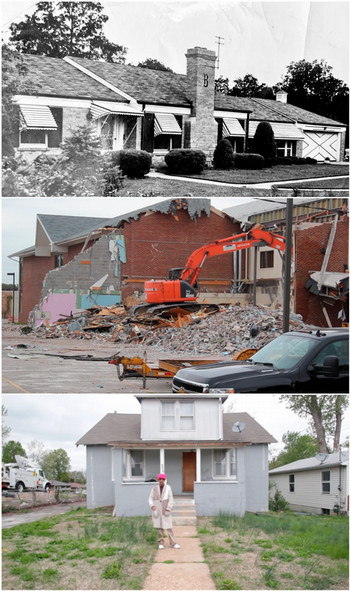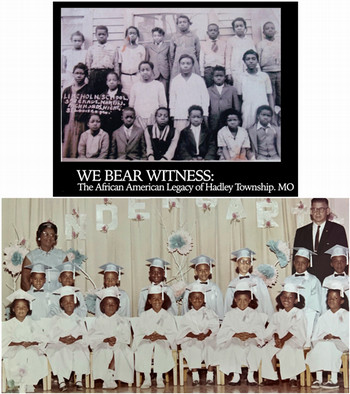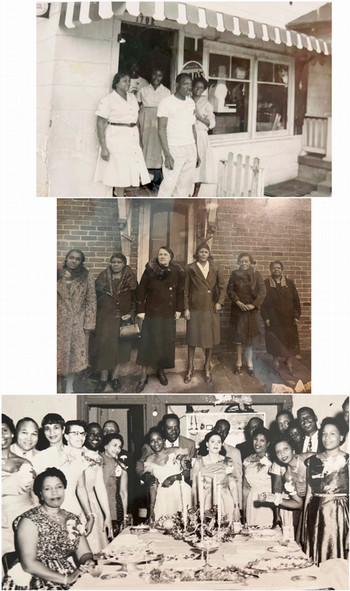Filmmaker Margie P. Hollins Debuts her Historic Film at SIUE on the Demolished Hadley Township in Missouri
“WE BEAR WITNESS” Chronicles the Prosperity, Promise and Destruction of the Black Town
 Margie P. Hollins’ sister called her hysterical and in tears. “They’re tearing down the church,” cried Marlene D. Peters. Hollins’ account of the heartbreaking scene is described in the story of the historic community in the documentary film, “WE BEAR WITNESS: The African American Legacy of Hadley Township, Mo.”
Margie P. Hollins’ sister called her hysterical and in tears. “They’re tearing down the church,” cried Marlene D. Peters. Hollins’ account of the heartbreaking scene is described in the story of the historic community in the documentary film, “WE BEAR WITNESS: The African American Legacy of Hadley Township, Mo.”
Southern Illinois University Edwardsville hosted the debut of Hollins’ “WE BEAR WITNESS” in the Lovejoy Library on Thursday, Feb. 6 at Dunham Hall Theater on the Edwardsville campus as part of SIUE’s Black Heritage Month events.
The screening was followed by a discussion with guest panelists: Dr. John A. Wright Sr., notable historian/Fulbright Scholar/author of “St. Louis: Disappearing Black Communities;” Gwen Moore, historian/Curator of Urban Landscape and Community Identity of the Missouri History Museum; the Honorable Mayor Reginald Finney, first African American Mayor of the City of Richmond Heights; and Hollins. Serving as moderator was WSIE 88.7 The Sound’s Robin Boyce, associate director of underwriting.
“Being on-site as they tore down Mount Zion Missionary Baptist Church, other structures and homes with a bulldozer on a beautiful sunny day in May 2014 was devastating,” said Hollins. “It reminded me of a war-torn place, similar to pictures I’ve seen of Beirut!”
Hadley Township was established in 1907 by Evens and Howard, a local brick-making company, to address its labor needs by recruiting African Americans during the Great Migration, who were seeking to escape lynchings and Jim Crow oppression in the south, according to Hollins. Historians claim the town was a prime target for elimination during the years of 1945-1951 when it faced a $750,000 bond issue that sought to turn it into a park and playground. The bond issue failed – twice – due to the leadership of Rev. James E. Fiddmont, pastor of Mount Zion Church, and Mildred Rusan, according to Hollins.
 Hollins addressed the audience before the screening of the 30-minute film that she wrote, directed, and produced.
Hollins addressed the audience before the screening of the 30-minute film that she wrote, directed, and produced.
“We were a small African American community who thrived because we were nurtured, talented and close-knit,” shared Hollins. “We were encouraged by Black teachers, and the African American community raised us. And when it came to achieving, we did. So, I stand here today to bear witness, and there are others in this room from the Hadley Township who can also attest to the greatness and legacy of our community.” Hollins’ family members were a part of the early residents. Her mother was five years old when she came to the Hadley Township in 1922.
In the film, former residents, business owners and community members were shown and interviewed, such as Helen Abron, gospel singer Doris Fiddmont Frazier, daughter of Rev. Fiddmont; Carol Hall and Melvin Martin. Also included was footage of buildings and structures where people once lived, shopped and thrived. Many of those interviewed on camera also talked about the importance of preserving the history of Black communities.
“Without a written and/or recorded history, future generations will never know the truth,” said Hollins. “Hadley Township has become one of the disappearing African American communities across the country.”
 Hollins would like to have a large virtual historical marker placed at the corner of Dale Avenue and Hanley Road that identifies the area as a former historic African American community site.
Hollins would like to have a large virtual historical marker placed at the corner of Dale Avenue and Hanley Road that identifies the area as a former historic African American community site.
Hollins recited a poem from the late Marthenia Bates Johnson Bonham, her seventh grade English and art teacher at the one-time New Lincoln School in the Hadley Township.
Portions of the poem read:
“I watched them tearing a Building Down
A gang of men in a Busy Town
With a Ho-Heave-Ho
And ... a lusty Yell
They struck a Beam
And a Side Wall Fell ...
I asked myself as I went my way
Which of these roles have I tried to Play
Am I a Builder who works with Care …
Or, Am I a Destroyer who walks through town
Content with The knowledge of
TEARING DOWN.”
(Marthenia Bates Johnson Bonham – 1955)
Photos: Courtesy of “WE BEAR WITNESS: The African American Legacy of Hadley Township, Mo.”









